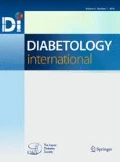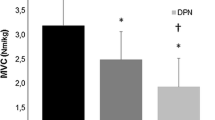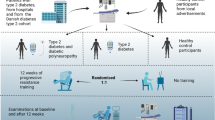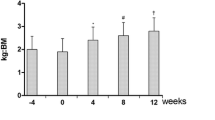Abstract
Background
The neuromuscular system generates human movement. The functional capacity of the neuromuscular system in patients with type 2 diabetes mellitus (T2DM) is decreased and this affects the generation of muscle force. Exercise is recommended as an effective treatment in such cases. Short-duration strength training causes neural adaptations in healthy participants, but the effects of strength training on T2DM are unclear. The present study aimed to evaluate the effect of strength training on neuromuscular efficiency of lower limb muscles in T2DM.
Methods
Surface electromyograms (SEMG) of the knee flexors and extensors were recorded during isometric contractions. The ratio of peak torque to SEMG amplitude was calculated as neuromuscular efficiency. Measurements were taken before the intervention after 6 weeks of non-training, and after 6 weeks of strength training.
Results
SEMG amplitudes did not differ among the subsequent measurement sessions. Flexor and extensor peak torque increased after the strength-training program. The neuromuscular efficiency of all muscles increased after the 6 weeks of strength training.
Conclusion
A 6-week strength-training program increased the neuromuscular efficiency and peak torque in patients with T2DM; however, the electrical properties of the muscles did not change. These results may be related to increased neural adaptations and motor learning in the early stages of strength training.
Similar content being viewed by others
References
Moritani T. Neuromuscular adaptations during the acquisition of muscle strength, power and motor tasks. J Biomech. 1993;26(Suppl 1):95–107.
Duchateau J, Semmler JG, Enoka RM. Training adaptations in the behavior of human motor units training adaptations in the behavior of human motor units. J Appl Physiol (Bethesda, MD: 1985). 2006;101(6):1766–75.
Power GA, Dalton BH, Rice CL. Human neuromuscular structure and function in old age: a brief review. J Sport Health Sci. 2013;2(4):215–26.
Sacchetti M, Balducci S, Bazzucchi I, Carlucci F, di Palumbo AS, Haxhi J, et al. Neuromuscular dysfunction in diabetes: role of nerve impairment and training status. Med Sci Sports Exerc. 2013;45(1):52–9.
Orlando G, Balducci S, Bazzucchi I, Pugliese G, Sacchetti M. Neuromuscular dysfunction in type 2 diabetes: underlying mechanisms and effect of resistance training. Diabetes/Metab Res Rev. 2016;32(1):40–50.
Watanabe K, Gazzoni M, Holobar A, Miyamoto T, Fukuda K, Merletti R, et al. Motor unit firing pattern of vastus lateralis muscle in type 2 diabetes mellitus patients. Muscle Nerv. 2013;48(5):806–13.
David P, Mora I, Pérot C. Neuromuscular efficiency of the rectus abdominis differs with gender and sport practice. J Strength Cond Res. 2008;22(6):1855–61.
Aragão FA, Schäfer GS, de Albuquerque CE, Vituri RF, de Azevedo FM, Bertolini GRF. Neuromuscular efficiency of the vastus lateralis and biceps femoris muscles in individuals with anterior cruciate ligament injuries. Revis Bras Ortop. 2015;50(2):180–5.
Farina D, Merletti R, Enoka RM. The extraction of neural strategies from the surface EMG. J Appl Physiol (Bethesda, MD: 1985). 2004;96(4):1486–95.
Arabadzhiev TI, Dimitrov VG, Dimitrova NA, Dimitrov GV. Interpretation of EMG integral or RMS and estimates of “neuromuscular efficiency” can be misleading in fatiguing contraction. J Electromyogr Kinesiol. 2010;20(2):223–32.
Patsika G, Kellis E, Amiridis IG. Neuromuscular efficiency during sit to stand movement in women with knee osteoarthritis. J Electromyogr Kinesiol. 2011;21(5):689–94.
Falla D, Jull G, Edwards S, Koh K, Rainoldi A. Neuromuscular efficiency of the sternocleidomastoid and anterior scalene muscles in patients with chronic neck pain. Disabil Rehabil. 2004;26(12):712–7.
Milner-Brown HS, Mellenthin M, Miller RG. Quantifying human muscle strength, endurance and fatigue. Arch Phys Med Rehabil. 1986;67(8):530–5.
Schimidt HL, Machado ÁS, Vaz MA, Carpes FP. Isometric muscle force, rate of force development and knee extensor neuromuscular efficiency asymmetries at different age groups. Revis Bras Cineantropometria Desempenho Hum. 2014;16:307–15.
Reid KF, Pasha E, Doros G, Clark DJ, Patten C, Phillips EM, et al. Longitudinal decline of lower extremity muscle power in healthy and mobility-limited older adults: influence of muscle mass, strength, composition, neuromuscular activation and single fiber contractile properties. Eur J Appl Physiol. 2014;114(1):29–39.
Cadore EL, Pinto RS, Pinto SS, Alberton CL, Correa CS, Tartaruga MP, et al. Effects of strength, endurance, and concurrent training on aerobic power and dynamic neuromuscular economy in elderly men. J Strength Cond Res. 2011;25(3):758–66.
Castaneda C, Layne JE, Munoz-Orians L, Gordon PL, Walsmith J, Foldvari M, et al. A randomized controlled trial of resistance exercise training to improve glycemic control in older adults with type 2 diabetes. Diabetes Care. 2002;25(12):2335–411.
Larose J, Sigal RJ, Boule NG, Wells GA, Prud’homme D, Fortier MS, et al. Effect of exercise training on physical fitness in type II diabetes mellitus. Med Sci Sports Exerc. 2010;42(8):1439–47.
Reeves ND, Narici MV, Maganaris CN. Effect of resistance training on skeletal muscle-specific force in elderly humans. J Appl Physiol (Bethesda, MD: 1985). 2004;96(3):885–92.
Gabriel DA, Kamen G, Frost G. Neural adaptations to resistive exercise: mechanisms and recommendations for training practices. Sports Med (Auckland, NZ). 2006;36(2):133–49.
Hovanec N, Sawant A, Overend TJ, Petrella RJ, Vandervoort AA. Resistance training and older adults with type 2 diabetes mellitus: strength of the evidence. J Aging Res. 2012;. https://doi.org/10.1155/2012/284635.
Louis TA, Lavori PW, Bailar JC, Polansky M. Crossover and self-controlled designs in clinical research. N Engl J Med. 1984;310(1):24–31.
Farina D, Cescon C, Merletti R. Influence of anatomical, physical, and detection-system parameters on surface EMG. Biol Cyber. 2002;86(6):445–56.
Carlo JDL. The use of surface electromyography in biomechanics. J Appl Biomech. 1997;13(2):135–63.
De Luca CJ, Adam A, Wotiz R, Gilmore LD, Nawab SH. Decomposition of surface EMG signals. J Neurophysiol. 2006;96(3):1646–57.
Davir Z. Isokinetic muscle testing interpertation and clinical applications. London: Churchill Livingstone; 2004.
Vigotsky AD, Halperin I, Lehman GJ, Trajano GS, Vieira TM. Interpreting signal amplitudes in surface electromyography studies in sport and rehabilitation sciences. Front Physiol. 2018;8:985.
Hatef B, Ghanjal A, Meftahi GH, Askary-Ashtiani A. Isokinetic and electromyographic properties of muscular endurance in short and long-term type 2 diabetes. Glob J Heal Sci. 2016;8(8):54366.
Hatef B, Bahrpeyma F, Mohajeri Tehrani MR. The comparison of muscle strength and short-term endurance in the different periods of type 2 diabetes. J Diabet Metab Disord. 2014;13(1):22.
Bazzucchi I, De Vito G, Felici F, Dewhurst S, Sgadari A, Sacchetti M. Effect of exercise training on neuromuscular function of elbow flexors and knee extensors of type 2 diabetic patients. J Electromyogr Kinesiol. 2015;25(5):815–23.
Botton CE, Umpierre D, Rech A, Pfeifer LO, Machado CLF, Teodoro JL, et al. Effects of resistance training on neuromuscular parameters in elderly with type 2 diabetes mellitus: a randomized clinical trial. Exp Gerontol. 2018;113:141–9.
Arakawa S, Watanabe T, Sone H, Tamura Y, Kobayashi M, Kawamori R, et al. The factors that affect exercise therapy for patients with type 2 diabetes in Japan: a nationwide survey. Diabetol Int. 2015;6(1):19–25.
Mangine GT, Hoffman JR, Gonzalez AM, Townsend JR, Wells AJ, Jajtner AR, et al. The effect of training volume and intensity on improvements in muscular strength and size in resistance-trained men. Physiol Rep. 2015;3(8):e12472.
Cannon RJ, Cafarelli E. Neuromuscular adaptations to training. J Appl Physiol (Bethesda, MD: 1985). 1987;63(6):2396–402.
Garfinkel S, Cafarelli E. Relative changes in maximal force, EMG, and muscle cross-sectional area after isometric training. Med Sci Sports Exerc. 1992;24(11):1220–7.
Cadore EL, Pinto SS, Alberton CL, Pinto RS, Baroni BM, Vaz MA, Lanferdini FJ, Radaelli R, González-Izal M, Bottaro M, Kruel LFM. Neuromuscular adaptations to concurrent training in the elderly: effects of intrasession exercise sequence. Age. 2013;35:891–903.
Guerrero-Berroa E, Ravona-Springer R, Heymann A, Schmeidler J, Silverman JM, Sano M, et al. Decreased motor function is associated with poorer cognitive function in elderly with type 2 diabetes. Dement Geriatr Cognit Disord Extra. 2014;4(1):103–12.
Yi SS. Effects of exercise on brain functions in diabetic animal models. World J Diabetes. 2015;6(4):583–97.
Uno K. Roles of the interorgan neuronal network in the development of metabolic syndrome. Diabetol Int. 2016;7(3):205–11.
Acknowledgements
This study was a residency thesis and was supported by Tarbiat Modares University. The authors would like to thanks the subjects for their participation in this study.
Author information
Authors and Affiliations
Corresponding author
Ethics declarations
Conflict of interest
The authors declare no conflict of interest regarding publication of this manuscript.
Additional information
Publisher's Note
Springer Nature remains neutral with regard to jurisdictional claims in published maps and institutional affiliations.
About this article
Cite this article
Shahrjerdi, S., Bahrpeyma, F., Savelberg, H.H.C.M. et al. Effect of a 6-week strength-training program on neuromuscular efficiency in type 2 diabetes mellitus patients. Diabetol Int 11, 376–382 (2020). https://doi.org/10.1007/s13340-020-00432-y
Received:
Accepted:
Published:
Issue Date:
DOI: https://doi.org/10.1007/s13340-020-00432-y




